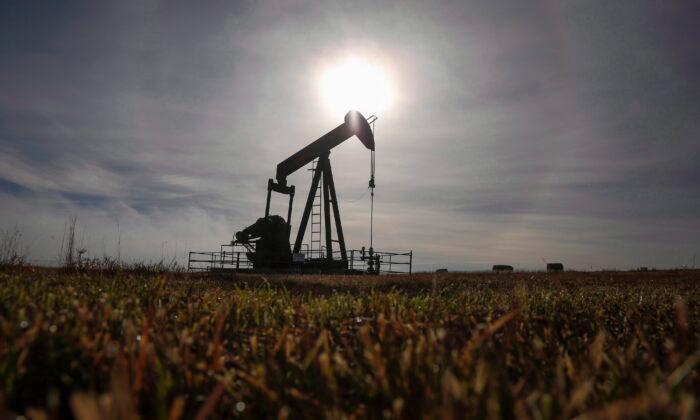On the cusp of 2021, the price of oil caught a bit of a tailwind, though going forward, a lot depends on how vaccinations and the return to a normal economy unfold. Oil supply appears to have less impact on price than oil demand, as producing nations keep digesting the lessons from a difficult 2020.
If the U.S. oil standard West Texas Intermediate (WTI) hovers in the low US$40s a barrel, companies can still survive and tread water, and supply won’t grow, said the ARC Energy Research Institute (ARC) in its Nov. 24 podcast. In this challenging environment for oil, what’s most needed is for demand to return and OPEC to open its spigots, instead of more investment, exploration, and drilling, the institute added.
The seemingly perpetual oversupply problem worsened in 2020 due to the sharp drop in demand because of the pandemic and a price war between Russia and Saudi Arabia. These factors acutely affected Canada’s oil patch.
The Canadian oil and gas sector has already been under pressure to reduce emissions for well over a decade, said ARC’s deputy director Peter Tertzakian in the podcast. But the industry is resilient and making strides in innovation to reduce its carbon footprint, aiming for a net-zero target.
One aspect of the pandemic has been how it has accelerated certain trends in society such as online shopping. It has also forced oil companies to deal with lower demand—expected as renewable sources gain traction—much sooner than anticipated.
“Lower commodity prices and reduced access to investment capital remain as accelerants to greater ingenuity and efficiency, not oblivion,” Tertzakian wrote in his 2021 outlook on Dec. 18. He sees the industry becoming increasingly capable of making money and competing at progressively lower prices.
Tertzakian also sees the oil and gas sector continuing to move toward fewer, larger players in pursuit of lower costs. He expects oil demand to rebound quickly in the second half of 2021.
BMO senior economist Art Woo wrote on Dec. 18 that it’s hard to see prices heading higher given the already remarkable rebound in the last three quarters of 2020.
He said that if the price of WTI approaches US$50, shale production could restart. He forecasted WTI to average US$47 in 2021 and US$50 in 2022.
Even with the uncertainties on the demand side, analysts agree that much rests on production cuts by OPEC+—a cartel consisting of the 14 members of the Organization of Petroleum Exporting Countries (OPEC) and 10 other oil-producing countries most notably Russia.
The International Energy Agency (IEA) only expects total energy demand to return to its pre-pandemic level by early 2023.
“The dramatic changes in consumer behaviour in 2020 have a limited overall effect on oil demand in the long run,” according to the IEA’s 2020 world energy outlook.
Demand Remains Strong but Market Access Lags
Demand for Canada’s oil benefits from the high environmental standards it meets and from the country’s stable political environment, says Canada Action, a group working to inform Canadians about the importance of Canada’s natural resource industries.
Another factor that could boost oil demand is that as oil gets cheaper, people will buy more of it, said Tertzakian. He said in the podcast that the introduction of energy-efficient devices in fact tends to bring down prices, leading people to use more energy.
A Nanos Research poll conducted in late November showed that 65 percent of Canadians say oil and gas is more important to Canada’s current economy than in the future.
Canada is a trading nation and its largest export is oil. Oil is a major source of tax revenues— which are being kneecapped due to the pandemic—and a major contributor to economic growth and prosperity.
Bank of Canada governor Tiff Macklem emphasized in a Dec. 15 speech that economic recovery must broaden to include a resurgence of exports, along with business investment, to be sustainable. He noted that oil is Canada’s “number one export.”
But he also raised the issue that Canada’s exports have been concentrated on mature economies with relatively slower growth, like the United States, rather than faster-growing economies in emerging markets, mainly in Asia.
Greater market access is key for Canada’s energy industry, as investment in cleaner oil-extraction technologies would dry up without it, Macklem said. Along with greater investment comes improvements in productivity and economic competitiveness.
He also noted that Canada’s onerous regulations and strong currency hurt the competitiveness of the country’s exports.
Oil Misses Commodities Boom
The U.S. dollar’s falling value in 2020, after a surge in March amid financial market turmoil, contributed to the rise in commodity prices, though oil has been one big exception.
Most non-oil resource prices posted double-digit gains in the past year, according to BMO. Lumber prices doubled due to the strength in housing construction. Copper, whose price tends to rise as economies recover, was the top-performing base metal thanks largely to China’s demand.
Meanwhile, oil had a rocky 2020. It began the year trading above US$60 and is likely to end the year down about 20 percent. On April 20, WTI traded with a negative price for the first time in history. Due to lack of storage, producers had to pay buyers to take oil off their hands since that was less costly than shutting down production.
While such an event sent a strong message to market participants to balance supply and demand, analysts say OPEC+ and others have since shown more discipline and the price of oil has more or less stabilized. However, they project a limited upside.





